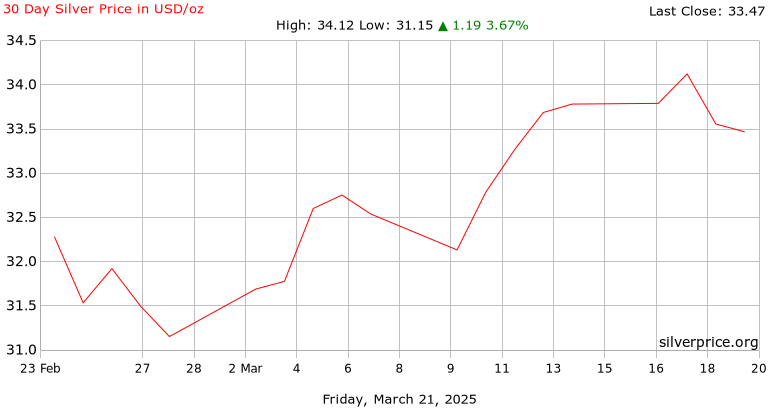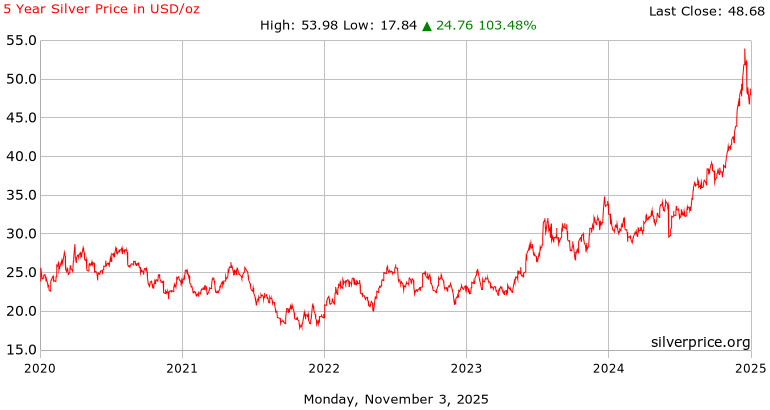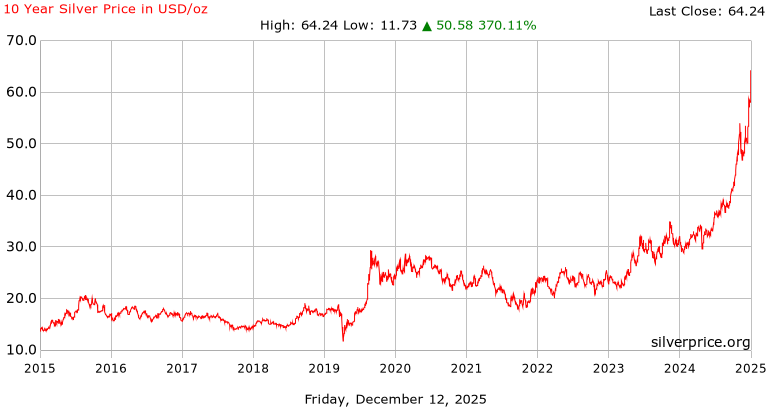Silver Price History
On this page you can explore silver’s price history. The main chart can provide over four decades worth of silver price history. In addition, the interactive charts can be used to examine historical silver prices by the ounce or kilo and in numerous currencies besides dollars.
Although past performance is not necessarily indicative of future results, looking at a market’s price history can potentially provide useful information. For example, looking at a silver price chart going back several months, if prices keep making higher highs and lower lows, then an uptrend may be present and prices could potentially continue higher.
In another example, looking at historical silver price data can also potentially help investors identify areas of support that could be solid buying opportunities. If silver has dipped down to $15 per ounce on numerous occasions but not gone lower, then buying interest may be strong at that level and it could potentially represent a good value for long-term buyers.
Four Decades of Performance
Using the main interactive chart below, you can easily view four decades worth of silver price history. Going back to the mid 1970s, silver was valued at less than $10 per ounce. The white metal began to rise in the late 70s, however, and by 1980 was valued at over $36 per ounce. The market saw prices come back down following the parabolic rise, and silver once again found itself trading under the $10 per ounce level by the late 1980s. Silver maintained a trading range under $10 for years to come, and prices would not climb above $10 per ounce until 2006.
2008 saw the price of silver basically double to about $20 per ounce. This may potentially have been due to the breaking financial crises of 2008/2009 that saw the global banking system nearly collapse. Silver prices once again came back down sharply to around the $10 per ounce level. This dip was bought aggressively, and silver began a historical climb in price that saw the market move nearly to $50 per ounce in 2011. This rapid and significant ascent in the price of silver could potentially have been fueled by significant risk aversion and concerns over the possible effects of massive quantitative easing measures to prop up the economy.
The silver market did not maintain trade near the $50 mark, however, and the white metal proceeded to trend lower over a few years until it found a possible bottom in 2016 for less than $14 per ounce.
Since that time, silver has recovered some ground and has essentially been range bound from about $16 per ounce to $20 per ounce.
A Very Long History
Silver, like gold, has been considered a reliable store of wealth and value for centuries. The metal has been used as a medium of exchange in many societies, and carries the same reputation for reliability to this day.
One of the major attractions to silver is its lack of counterparty risk and its inherent value. Unlike a fiat, or paper currency, silver cannot be printed at will. Fiat currencies have historically lost value over time, and hard assets like silver may potentially hold their value in spite of declining paper money values.
This can potentially make silver especially attractive during periods of rising inflation. During such periods, the overall cost of goods and services rises, and the purchasing power of paper currency may contract. Silver, and other hard assets, may potentially hold their value better or even possibly rise in value as price pressures climb.
Silver, unlike other times in its history, may potentially benefit from several key factors including an ongoing rise in industrial demand as well as central bank monetary policies and geopolitics. In the last decade, global central banks have fought off a slowing economy using ultra-low rates and massive QE. Some would argue that these tools have been successful, while others may differ in their opinion. The ability of central bank’s however, to print massive amounts of currency could potentially weigh on paper currencies in the decades to come, making silver and other hard assets potentially more attractive to long-term investors.
Silver has stood the test of time as a reliable store of wealth and value, and the white metal is likely to continue to be sought after for its price appreciation potential and its potential to provide a meaningful hedge against numerous economic and geopolitical issues.
















